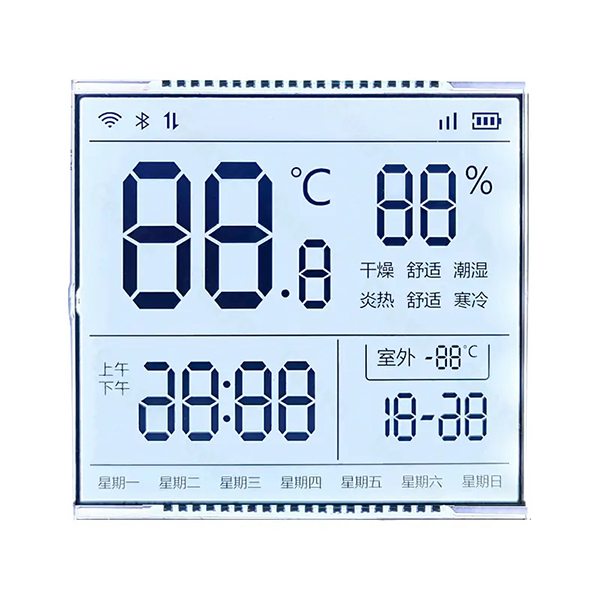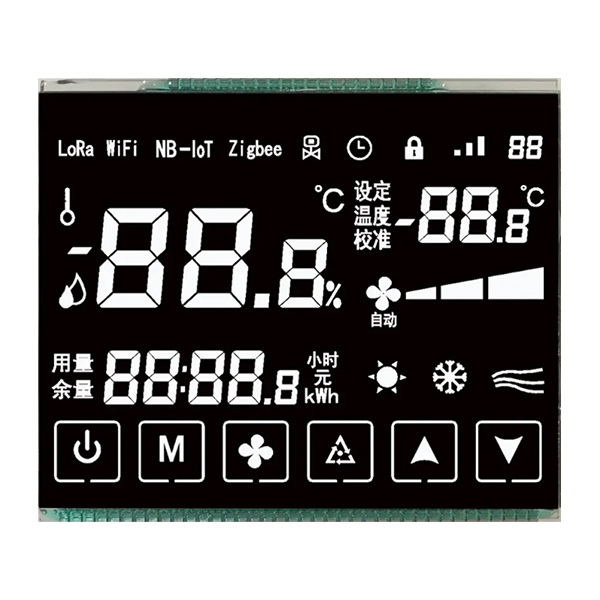
2025-05-23
Key words: LCD/LCM/TFT/TN/HTN/VA/STN/FSTN, ultra wide temperature, liquid crystal molecules, temperature, optical rotation, transmittance, contrast, auxiliary temperature compensation
Liquid crystal products such as LCD, LCM and TFT are widely used in industrial instruments, household appliances, automotive electronics and medical equipment, which are important carriers and media of human-computer interaction in modern society. Temperature characteristics are the key to the performance of liquid crystal materials. Below we will explain the relationship between liquid crystal and temperature changes:
① It is commonly said that matter exists in three states: solid, liquid, and gas. Liquid crystal is considered the fourth state, as it lies between liquid and solid, with a unique molecular arrangement. Under different temperature conditions, the arrangement of liquid crystal molecules changes significantly, which directly affects the molecular changes of the liquid crystal, thus influencing its optical properties and ultimately its display performance.
② Within the 0-50℃ temperature range, the thermal motion of liquid crystal molecules is relatively weak, and the molecular arrangement is more orderly. For example, in nematic liquid crystals, the molecules are neatly aligned in a specific direction, much like a well-trained squad of soldiers. This orderly arrangement allows light to pass through the liquid crystal more smoothly, making the liquid crystal's optical properties most stable in this temperature range. This results in the best display performance of liquid crystal displays.
③ As the temperature gradually increases to 50-90℃, the liquid crystal molecules gain more energy, leading to increased thermal motion. The molecular arrangement becomes less regular and more disordered. This change in molecular arrangement results in more scattering and refraction of light during its propagation. For example, if many stones are thrown into a calm lake, the originally straight path of light is disrupted, reducing the intensity of light passing through the liquid crystal, thus decreasing the transmittance. Consequently, the contrast of the liquid crystal display decreases, and the display quality is compromised.
④ As the temperature continues to rise, exceeding 90℃, the arrangement of liquid crystal molecules undergoes more significant changes when a certain critical point is reached. The liquid crystal may transition from one phase to another, such as from an alignment phase to a isotropic phase. During this transformation, the optical properties of the liquid crystal undergo a sudden change, and the light transmittance also changes significantly. For example, when certain specific liquid crystal materials reach this critical temperature, the liquid crystal, which was initially transparent, suddenly becomes cloudy, with a sharp decrease in light transmittance. This is because the degree of molecular disorder significantly increases, making it almost impossible for light to pass through smoothly. At this point, the display function is lost, and the material cannot be used for display.
⑤ Low temperature: 0—-45℃, the viscosity of liquid crystal materials drops sharply. In low-temperature environments, the viscosity increases, slowing down the rotation speed of liquid crystal molecules and increasing the response time, which can result in dynamic image trailing or residual images. This temperature range is frequently encountered in daily life and production, and improving display performance in this temperature range remains a significant challenge for the industry. Dalian Eastern Display Co. As a company with over 30 years of professional experience, we have a solid technical foundation. Our ultra-wide temperature VA/TN/HTN segment liquid crystal screens can ensure display without auxiliary devices; our STN/FSTN dot matrix screens can also ensure display with improved driving and auxiliary temperature compensation.
⑥ When the temperature is lower than-50℃, the viscosity of liquid crystal material exceeds the driving capacity of electrical signals, and the arrangement of molecules enters a stagnant state, no longer has optical rotation, and the liquid crystal display also loses the display function. At present, there is no breakthrough in this technical problem in the industry.
In summary, the relationship between liquid crystal and temperature is a complex yet fascinating field of study, involving the interaction of various factors, including the physical properties of liquid crystal materials, their molecular structure, and external environmental conditions. Dalian Eastern Display Co. Ltd. 's technical team will continue to delve deeper into this relationship, aiming to produce liquid crystal displays with superior performance and to serve all our customers well.

